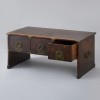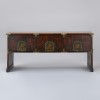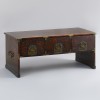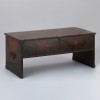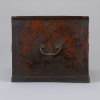본문
서안(書案)은 조선시대 사대부가의 사랑방이나 서실에서 책을 읽거나 글을 쓰는 데 사용된 평좌식 책상입니다. 좌식 생활에 맞게 낮은 형태로 만들어졌고, 주인의 자리를 은연중에 드러내는 상징적 역할도 하였습니다.
넓은 천판(天板)과 이를 지탱하는 판재형(板材形) 다리, 그리고 전면에 서랍 세 칸으로 이루어져 있습니다. 짙은 옻칠 바탕과 문양이 투각된 금속 장석은 단정하면서도 기품 있는 미감을 보여주고, 측면의 손잡이는 이동의 편리성을 고려하였습니다.
조선시대 서안은 오늘날까지 전하는 온전한 사례가 많지 않아, 당시의 생활 공간과 사대부가의 문화를 이해하는 데 중요한 자료가 됩니다.
━━━━━
书案是朝鲜时代士大夫在客厅或书房中用于读书和写字的平座式书桌。为了适应就地而坐的生活方式,书案整体低矮,同时也象征性地彰显主人的地位。
书案由宽大的桌面支撑在板材式桌腿上,前方设有三格抽屉。深色漆面底色与镂空金属装饰呈现出端庄而典雅的美感,侧面的提手设计便于移动。
朝鲜时代的书案完整流传至今的实例不多,是研究当时生活空间与士大夫文化的重要资料。
━━━━━
A seoan is a low, flat writing desk used by literati in the sarangbang (study quarters) of a scholar’s house during the Joseon dynasty. Suited for a floor-seated lifestyle, it functioned both as a practical desk for reading and writing and as a subtle indicator of the scholar’s social standing.
This example consists of a broad top panel (cheonpan), plank-style legs, and three drawers along the front. The dark lacquered finish and pierced metal fittings provide a refined and dignified aesthetic, while side handles were added for ease of movement.
Because relatively few intact scholar’s desks from the Joseon dynasty survive today, pieces like this are invaluable for understanding the daily living spaces and cultural practices of the literati class.


